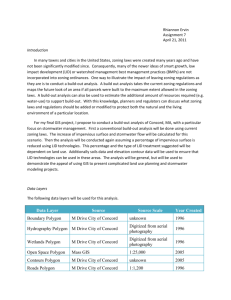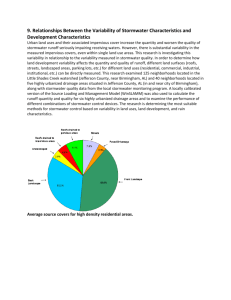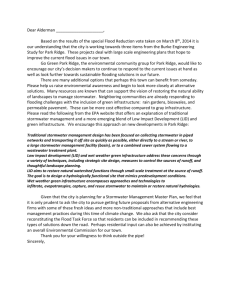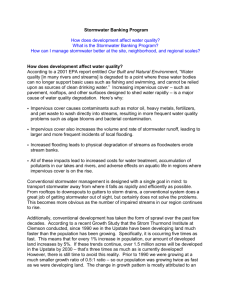FINAL PAPER
advertisement
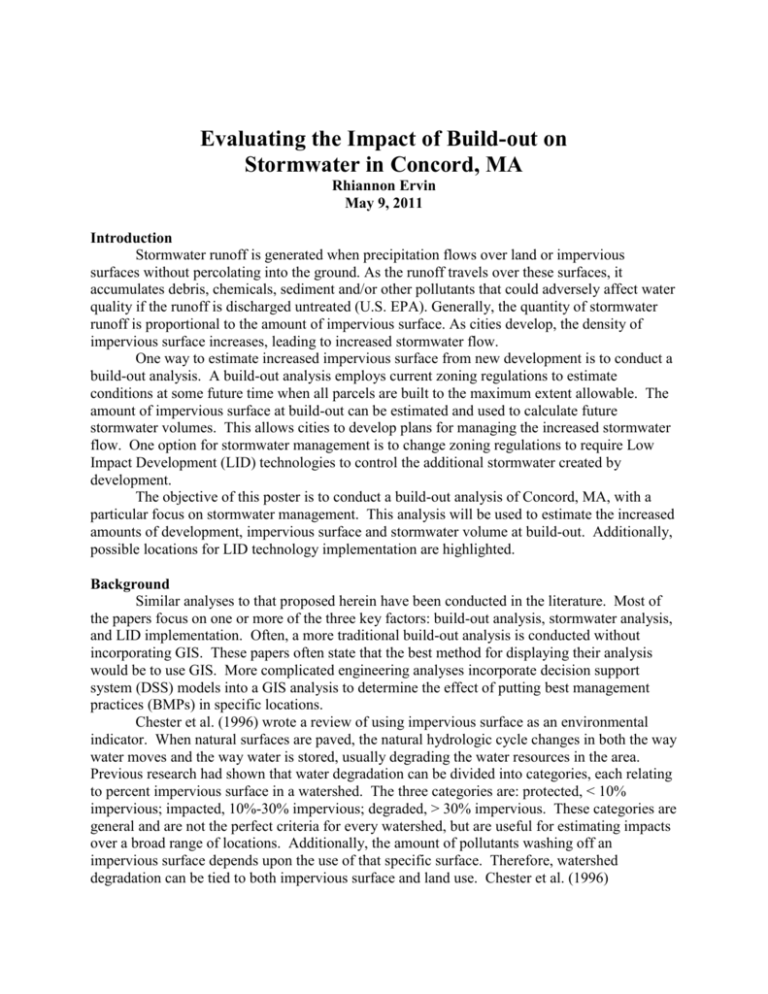
Evaluating the Impact of Build-out on Stormwater in Concord, MA Rhiannon Ervin May 9, 2011 Introduction Stormwater runoff is generated when precipitation flows over land or impervious surfaces without percolating into the ground. As the runoff travels over these surfaces, it accumulates debris, chemicals, sediment and/or other pollutants that could adversely affect water quality if the runoff is discharged untreated (U.S. EPA). Generally, the quantity of stormwater runoff is proportional to the amount of impervious surface. As cities develop, the density of impervious surface increases, leading to increased stormwater flow. One way to estimate increased impervious surface from new development is to conduct a build-out analysis. A build-out analysis employs current zoning regulations to estimate conditions at some future time when all parcels are built to the maximum extent allowable. The amount of impervious surface at build-out can be estimated and used to calculate future stormwater volumes. This allows cities to develop plans for managing the increased stormwater flow. One option for stormwater management is to change zoning regulations to require Low Impact Development (LID) technologies to control the additional stormwater created by development. The objective of this poster is to conduct a build-out analysis of Concord, MA, with a particular focus on stormwater management. This analysis will be used to estimate the increased amounts of development, impervious surface and stormwater volume at build-out. Additionally, possible locations for LID technology implementation are highlighted. Background Similar analyses to that proposed herein have been conducted in the literature. Most of the papers focus on one or more of the three key factors: build-out analysis, stormwater analysis, and LID implementation. Often, a more traditional build-out analysis is conducted without incorporating GIS. These papers often state that the best method for displaying their analysis would be to use GIS. More complicated engineering analyses incorporate decision support system (DSS) models into a GIS analysis to determine the effect of putting best management practices (BMPs) in specific locations. Chester et al. (1996) wrote a review of using impervious surface as an environmental indicator. When natural surfaces are paved, the natural hydrologic cycle changes in both the way water moves and the way water is stored, usually degrading the water resources in the area. Previous research had shown that water degradation can be divided into categories, each relating to percent impervious surface in a watershed. The three categories are: protected, < 10% impervious; impacted, 10%-30% impervious; degraded, > 30% impervious. These categories are general and are not the perfect criteria for every watershed, but are useful for estimating impacts over a broad range of locations. Additionally, the amount of pollutants washing off an impervious surface depends upon the use of that specific surface. Therefore, watershed degradation can be tied to both impervious surface and land use. Chester et al. (1996) demonstrate how maps of the current built state and the future build-out state can be used to show stakeholders the degradation of the watershed in both instances. Maps were created using satellite imagery, from which general land-cover categories and estimates of impervious surface were taken. The authors then suggested that the maps be used to aid regional and local planning, as well as modify regulations. They suggest that from this rough build-out analysis planners should revisit zoning requirements and emphasize the minimization of impervious surface in future development. In their 2005 paper, Conway and Lathrop discuss the use of local scale watershed management to “bridge the gap between land use planning and natural resource management”. They particularly focus on build-out analysis for examining future landscapes, before permanent changes occur. To present the utility of the build-out analysis, the authors conducted four buildout scenarios for the Bamegat Bay Estuary in New Jersey: 1) Current regulations scenario: based on current zoning and environmental regulations; 2) Down zoning scenario: minimum lot size is increased; 3) Large buffer scenario: down zoning with an increased buffer around all freshwater; 4) Open space scenario: down zoning scenario with a more aggressive plan to protect open space. For each scenario maps were created to show future land use and percent imperviousness. The authors then proposed that these maps be shared with regulators to help them understand the impact of current and future zoning and regulations. Sample et al. (2001) demonstrate the utility of combining GIS with water resources decision support systems (DSS) for local scale stormwater management. In general, DSS incorporate hundreds of variables and use complicated algorithms to solve the optimization problem. Sample et al. (2001) state that “the strength of GIS is that it can be used as a common ground between specialists and nonspecialists to help them communicate effectively.” To this end, the authors examine a developed mix use neighborhood to determine what best management practices (BMPs) could be added to the neighborhood to return stormwater characteristics to predevelopment conditions. The analysis used GIS data layers to calculate, the curve number, which assigns different levels of change to the natural hydraulic system depending on land use and impervious surface. Then, the amount of land that should be dedicated as BMP locations to make up for the change in the hydraulic system is calculated. At this point, an optimization routine can be run to determine the lowest cost locations to implement BMPs. In their 2010 paper, Viavattene et al., create a GIS-based BMP model to examine the reduction in stormwater runoff through BMP implementation. They say that one strength of this model is that the GIS interface allows it to be used by “a range of local authority/municipal, federal/state regulatory agencies, drainage engineers/consultants and other interested stakeholders in the development and evaluation of stormwater drainage infrastructure contained within stormwater management plans.” Viavattene et al. (2010) demonstrate the effectiveness of their tool using a case study of the urban regeneration project in the city of Birmingham, UK. This city was chosen because (as of 2007) a large part of the sewer network surcharged during 5year rainfall events. The user is able to use the “ADD BMP Tool” to add appropriate BMPs to data layers. Running the model before and after BMP implementation showed that the same number of sewer surcharges occurred, but that the flow of each surcharge was greatly reduced due to the BMPs. The tool showed the user that the specific selection of BMPs helped reduce the magnitude of the problem, but that more modifications would be necessary to completely eradicate the problem. Data Layers Data Layer Boundary Polygon Source M Drive City of Concord Hydrography Polygon M Drive City of Concord Wetlands Polygon M Drive City of Concord Open Space Polygon Roads Polygon Mass GIS M Drive City of Concord Buildings Polygon M Drive City of Concord Easements Polygon Zoning Polygon Parcels Polygon Edge of Pavement line data Soils Polygon M Drive City of Concord Mass GIS M Drive City of Concord M Drive City of Concord M Drive City of Concord Source Scale unknown Digitized from aerial photography Digitized from aerial photography 1:25,000 1:1,200 Digitized from aerial photography unknown unknown 1:1,200 Digitized from aerial photography 1:24,000 Year Created 1996 1996 1996 2005 1996 1996 2005 2007 1996 2007 2005 Methods Examine current conditions Separate zoning layers for the residential (R1, R2, R3 and R5), light industrial, general industrial and limited business zoning regulations were created. This was done to facilitate the multiple following steps requiring the selection of an object lying within each specific zoning designation. The impervious surface area of the current conditions was calculated using the building footprint polygon, the roads polygon and the edge of pavement dataset. For both the polygon data sets, the “statistics” tool was used to measure their area. Since the roads polygon does not always include smaller roads and driveways, the additional amount impervious surface for limited business, light industrial and general industrial was calculated using the “measure” tool on the edge of pavement line data. The residential areas are large and have too many small driveways to measure each individually. Therefore, total additional impervious surface was calculated by measuring the amount of additional impervious surface in a representative area, for each residential zoning type and assuming that the rest of the zoning designation had similar impervious characteristics. Create layers of already built-out land For residential zoning designations, the “select by location” tool was used to select parcels whose centroid lies within the zoning layer. Then, the selection was narrowed to all parcels having a shape area less than twice the minimum lot size shown in Table 1. The rational here is that any lot greater than twice the minimum lot size could be split in half and further developed. New layers of built-out land were created from these selections. Table 1. Minimum residential lot size and selection criteria for built-out land Residential Zoning Designation R1 (>80,000 sq. ft.) R2 (40,000-79,999 sq. ft.) R3 (20,000-39,999 sq. ft.) R5 (5,000-14,999 sq. ft.) Min Lot Size (sq. ft.) 80,000 40,000 20,000 10,000 Selection Criteria (sq. ft.) < 160,000 < 80,000 < 40,000 < 20,000 The same method was not applicable to industrial and limited business parcels because though most of these parcels are larger than the minimum lot size, they are covered with large impervious surface areas. Since impervious surface is the principal component of this particular build-out analysis, these lots already covered with impervious surface are considered built-out. The area of Concord zoned for Light Industrial, General Industrial, and Limited Business is small, which allowed these areas to be examined parcel by parcel to determine buildable areas for creation into new layers. Determine buildable land Starting with the zoning polygon, use the “erase” tool was used to remove the built-out layers created above. Then the “erase” tool was also used to remove roads, protected open space, hydrography, wetlands, floodplains and easements. Estimate the area of impervious surface at built-out The “summarize” tool was used to calculate the land area of each zoning type in the build-out scenario. Using the built-out data layers, the ratio of impervious surface to land area of built-out parcels was estimated for each zoning type. The buildable land area for each zoning type was multiplied by its corresponding ratio to determine the amount of impervious surface at build-out. Calculate the effects of build-out on stormwater flow A general rule of thumb used in stormwater analysis is that approximately 90% of pollutants in stormwater are found in the first half inch of rainfall for each storm. After the first half inch has fallen, most of the pollutants are expected to be already washed from the impervious surfaces. Therefore, a one stormwater management criterion is to capture and control this “first flush”. This analysis used 0.5 in. of rainfall to calculate the amount of stormwater caused by impervious surfaces that needs to be managed. To do this, the area of impervious surface at both current and build-out conditions was multiplied by 0.5 in to calculate a volume of stormwater. Assess possible locations for LID implementation In order for LID technologies that discharge stormwater back into the ground to effectively manage stormwater, they must be built on soils that can transmit the water at a high enough rate. If the soils cannot transmit the water, flooding will occur. Therefore, the soils polygon was used to find locations that where the soil drainage is moderately well drained or higher. Results Current Conditions Concord is currently zoned to be 94.7% residential, 1.0% limited business and 3.7% industrial. Analysis of the building footprint polygon, roads polygon and edge of pavement polygon were used to determine that approximately 7.3% of the land surface is impervious. Examination of parcel data determined that 25.3% of Concord is already built to the maximum extent allowed by the zoning regulations. The light industrial and high density residential zoning designations have the highest percentage of their land already built-out, at 42.9% and 48.8%, respectively. Land designated as limited business is only 1.3% built-out. However, as limited business is only 1% of the total land area, additional construction in these districts is unlikely to have a large impact on stormwater. Build-out Analysis As stated previously, the land available for development was determined by erasing the already built-out land, surface water and protected areas from the total area of Concord. This build-out analysis shows that 29.5% of the land area is still available for development. At buildout, 54.8% of the land in Concord will be developed. As shown in Table 2 only 25-30% of the land designated as residential is available for development, while 50-65% of the land designated as business or industrial can be developed. However, since the total amount of land set aside for business and industrial development is small compared to the size of Concord, the largest amount of land available for development (22%) is zoned as low density residential. Once buildout is reached, approximately 12.7% of the Concord land surface will be impervious. Table 2. Buildable land statistics Buildable Land Zoning Designation 5,000-14,999 sq. ft. 20,000-39,999 sq. ft. 40,000-79,999 sq. ft. > 80,000 sq. ft. Limited Business Light Industrial General Industrial % Of Total Land 3.9 12.7 28.2 49.9 1 1.7 2 % of Zoning Designation 24.7 28.9 25.8 29.4 51.8 60.2 65.0 % of Total Land 1.0 3.7 7.3 14.7 0.5 1.0 1.3 Stormwater and LID Analysis One of the most important components of a stormwater analysis is to determine the volume of stormwater created in the first half inch of rainfall. Because this “first flush” carries approximately 90% of the stormwater pollutants, capturing and treating this water can significantly reduce the impact of development on the water quality of the area. Currently, the 1.9 square miles of impervious surface in Concord produces 2.2 million cubic feet of stormwater during the first 0.5 in of rainfall. At build-out, the additional 1.4 square miles of impervious surface will add another 1.6 million cubic feet of stormwater. According to the environmental indicator developed by Chester et al. (1996) the increase of impervious surface from 7.3% - 12.7% will move Concord’s water quality from “protected” to “impacted”. However, if zoning regulations are changed to require developers to capture and treat the volume of stormwater created due to their development, Concord could continue to have an effective impervious surface of 7.3%. This would keep the watershed in the “protected” category. One of the best ways to treat this additional stormwater would be to incorporate LID technologies into the new developments. Unlike traditional engineering solutions for managing stormwater, LID systems can be incorporated into development without ruining its visual appeal. Many of these technologies directly input the stormwater back into the ground. For this to work and not flood the surrounding area, the LID technology needs to be built on soils that are able to drain quickly and transmit the volume of stormwater directed into the ground. Therefore, a soil drainage map was created to visualize the drainage characteristics of the buildable land. Any soil moderately well drained or higher is deemed a good location of LID implementation. In Concord, 84.8% of the buildable land is well drained enough to support these technologies. Therefore, LID implementation seems like a reasonable method for handling stormwater due to increased development in Concord. Conclusions and Caveats A GIS based build-out analysis shows that developed land in Concord, MA will increase from 25.3% to 54.8%. Most of the development will occur in low density, residential areas. Many assumptions were made to complete this build-out analysis. One of the key difficulties was that the data sets range in creation date from 1996-2005. Additionally, a rigorous assessment of the accuracy of each data set was not performed. The build-out analysis conducted does not represent the most built-out Concord could become because of the method used to determine parcels that are already built-out. Parcels less than twice the minimum lot size were determined to be already built-out. It is likely that many of these parcels could add more development and impervious surface while still following zoning regulations. Impervious surface of the current conditions was estimated by combining building footprint, road and edge of pavement data. Since the edge of pavement data was a line data set, the area of this data set could not be calculated using ArcGIS. The additional impervious surface from the edge of pavement data was estimated using the measure tool for a small section in each zoning type and then assumed to apply to the entire zoning type. If the impervious surface to land area ratio is not homogeneous throughout a zoning designation, this method could easily underestimate or overestimate the amount of impervious surface. Additionally, these same ratios were used to estimate the impervious surface area of future developments. Though this could make both current and future estimates incorrect, the analysis is consistent for both time frames. The stormwater analysis conducted for this project was very preliminary. Though a “first flush” assessment is good for handling some stormwater pollutants, it does not apply to all pollutants of concern. Additionally, the other principal problem with growing development and impervious surface is flooding from increased stormwater flow. Flooding was not addressed at all in this assessment. To look at the effects of build-out on flooding, one would need to create impervious surface connectivity data sets, look at local slopes and use other design storms in addition to the first half inch. However, the assessment done in this project would be adequate preliminary work to set up for a flooding analysis. Lastly, the LID assessment conducted in this project was also very preliminary. Whether or not LID should be implemented at all, as well as the various types of LID that should be used depend on much more than soil drainage data. Among other things they depend on land use, land slope and proximity to sensitive environments. All of these things could be examined using GIS, but ultimately site visits are necessary to select acceptable locations for LID implementation. Overall, this build-out analysis and stormwater assessment of Concord, MA is an adequate preliminary assessment. The visuals created would be helpful for planning and community meetings to demonstrate what the area could look like under the current zoning conditions. They also give planners an estimate of the increased stormwater that will need to be managed in the future. However, any future designs and changes of zoning regulations would require a more in depth analysis of all areas touched on in this project. References Arnold Jr., Chester L. and Gibbons, C. James. 1996. Impervious Surface Coverage: The Emergence of a Key Environmental Indicator. Journal of the American Planning Association, 62: 2, 243 — 258. Conway, M. and R.G. Lathrop. 2005. Alternative land use regulations and environmental impacts: assessing future land use in an urbanizing watershed. Landscape and Urban Planning 71: 1–15. Sample, D.J., Heaney, J.P., Wright, L.T., and R. Koustas. 2001. Geographic Information Systems, Decision Support Systems, and Urban Storm-water Management. Journal of Water Resources Planning and Management, May/June 2001 Viavattene, C., Ellis, J.B., Revitt, D.M., Seiker, H and Peters, C. 2010. The application of a GISbased BMP selection tool for the evaluation of hydrologic performance and storm flow reduction. Proc. 7th Int.Conf. Sustainable Techniques and Strategies for Urban Water Management; NOVATECH10. 28 June – 1 July 2010. GRAIE, Insa de Lyon. Lyon, France.


